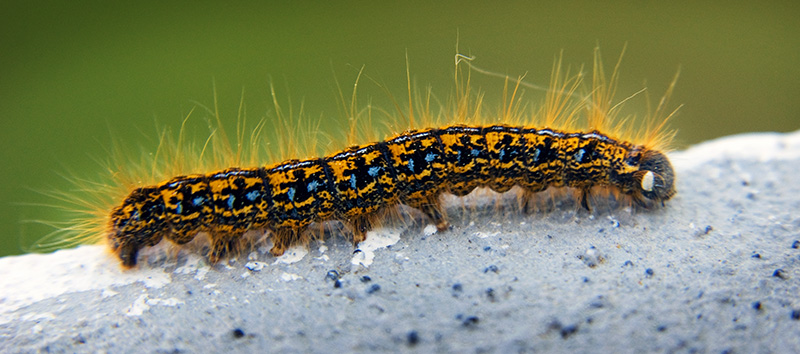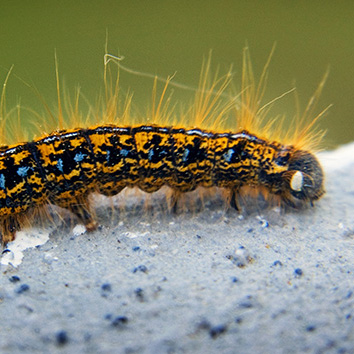
Tent Caterpillar. Photo by Rambling Artists used with permission.
A plague is what it felt like, though there were no human casualties that I know of—just flowers and fruits and many, many leaves. It’s the annual tent caterpillar invasion in the Pacific Northwest.
About a month ago, I was walking down the street to visit a friend and noticed a large, furry caterpillar near me on the pavement, walking—well, moving—in the opposite direction. A fellow traveler, I thought.
That was before I knew. That was before I noticed that thousands upon thousands of these ravenous insects had established residence in my own backyard, living in the branches of the cherry and apple trees, decimating this year’s crop. To be specific, this year my two apple trees will bear two pieces of fruit.
What do you do when faced with a plague? What is the conscious response?
First, I tried to get to know this caterpillar and learned, through research, that it has some lovely social habits. Tent caterpillars live in colonies. Each colony constructs a gauzy silk tent, large enough to hold many generations. The caterpillars situate these cocoons on the high branches of various kinds of deciduous trees, choosing, whenever possible, the side that gets morning sunlight. The idea is warmth. On chilly spring mornings the air inside these protective tents can be up to be 50F degrees warmer than outside. Once the day has warmed, the caterpillar leaves home to forage—that is, to eat… and eat… and eat.
Even knowing more about the caterpillars, still I wanted to kill them. I suppose if there had been just one tent in my yard, I would have been happy to share the leaves. But there were so many tents. I spent a few hours cutting down all I could reach and then—happily a renter—called my landlord and asked if he would come with his truck and take these (some 25) nests away. “There were thousands of caterpillars,” he said later, awe in his voice.
And that wasn’t the end of it. More arrived in the yard, built new nests, and these, when I could reach them, I cut down, burning them one by one over a candle on my front walk. It’s personal, burning something alive. I started out saying, “May you go to a better life.” But after a while, I knew I didn’t mean it; my goal was that the caterpillars leave this life.
Finally, I heard about a “biologically safe” insecticide: something that makes the caterpillars unable to eat but doesn’t affect birds that may eat the caterpillars—not many do—and doesn’t affect people who eat the leaves. It’s dicey, I know, but I was losing a battle for my own backyard.
And, of course, they weren’t in just my yard. They were all over the island. These are forest tent caterpillars, and Whidbey is a forested island. The local folk wisdom is that the caterpillars live in seven-year cycles. “One year it was so bad,” my landlord said, “that coming over on the ferry, I saw that the hillsides were brown—the caterpillars had eaten everything.” After a year like that, the understanding is, there will be very few caterpillars on the year following. I guess there’s nothing left to eat.
They’re on the wane now; caterpillars eat only new leaves so the season is actually over. This was a bad year, everyone acknowledges, but there are those who say that 2015 is going to be worse.
If that’s the case, I may be ready to explore another ploy I discovered in my research: tent caterpillar wine.
You know the old saying: when you’re given lemons…

